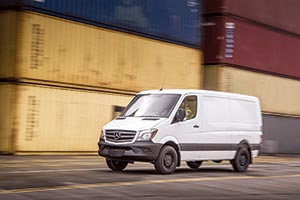Cargo Van Manufacturers Beef Up Models With More Customization, New Technology

This story appears in the Oct. 17 print edition of Transport Topics.
The role of commercial cargo vans — essentially motorized boxes — hasn’t changed in 50 years, but practically everything else about the vehicles has changed over the past decade. This generation of vans offers more safety features, more cargo room, more carrying capac- ity, more power, more technologies and more options than their predecessors. And for the most part, they look different, too.
Combine those changes with a recovering economy, and that’s why cargo van manufacturers are enjoying double-digit sales growth. Sales of all size vans — full-size and compact — topped 423,000 in 2015, their best year since 2009, and were up an additional 16% through August, according to several industry sources.
“Van sales parallel employment,” said Dave Sowers, head of Ram Truck marketing of commercial vehicles. “As more jobs open up [with] construction and trade work, owners who had been holding off and hanging on to their units finally began to turn them over.”
The industry is on target to sell about 350,000 full-size vans this year, up from about 105,000 after the 2008 recession, said Mark Namuth, senior manager of Nissan commercial vehicle sales in North America. “Customers have moved up their trade cycles,” he said. “There’s greater incentive to trade in right now.”
Total units sold are still significantly lower than pre-recession numbers, and manufacturers are optimistic that there is room to grow, said Joe Langhauser, product manager of commercial vans for General Motors Co. “We feel there is still much appetite for full-size vans, due in large part to the many ways in which fleet owners and small businesses can customize the van to fit their needs.”
Meanwhile, all of the full-size cargo vans today, except for General Motors’ entrants, have been either designed or influenced by units built for international markets. The shift to this new generation of vans began in 2001 with the North American introduction of the Mercedes-Benz-built Sprinter. With its Euro-style look, diesel-only power, variable roof heights and wheelbases, the Sprinter offered the first real competitive option to the standard van in decades.
The Sprinter was sold in the United States first under the Freightliner and Dodge Ram brands but now is available as Mercedes-Benz and Freightliner units, both subsidiaries of Daimler AG.
Mercedes-Benz Vans delivered about 28,600 units to U.S. customers in 2015, the company said. That’s an 11% increase from 2014 and makes the United States the second-largest market for Sprinter after Germany. The van is built in Stuttgart, Germany, but Mercedes- Benz announced this past summer that it would open an assembly plant in North Charleston, South Carolina, by 2018.
Nissan Commercial Vehicles entered the market in 2008 with the NV series. In 2010, Ford introduced the Transit Connect, a Turkish-built Class 1 small van adopted for the U.S. market, and the full-size Transit followed in 2013. After Chrysler merged with Fiat, Dodge Ram dropped the Sprinter to offer the ProMaster, based off of Fiat’s Ducato van.
The most notable effect of this internationally inspired movement has been that cargo vans long ago moved beyond the simple, refrigerator-on-wheels style used for years. Gone are the days when the main options were wheelbases and body length.
When taking into account roof heights, wheelbase lengths and other variables, vans today are available in many combinations. The 2017 Ford Transit, for example, is available in 64 configurations.
This increase in specs has expanded their utilitarianism. Cargo capacities can range up to 586 cubic feet, and payloads can top 5,500 pounds, depending on configuration. Full-size vans accommodate pallets, some from both the rear and the side doors, while high roof heights let drivers stand in the box and work.
“For 30 years, the industry standard was one type of van: rear-wheel drive, body on frame, with few options,” said Ram’s Sowers. “[Most of] the new vans are unibody with different roof heights and very customizable. The vans have become so [much more] versatile that customers are downsizing to vans from trucks.”
Another difference between the generations is high-tech safety and communication technologies, such as several air bags, speed limiting, electronic stability control, lane departure warning systems, telematics and communications systems. Some type of these systems is either standard or optional on all vans.
“Fleet guys are starting to look for safety technologies more common in passenger cars,” Sowers said. “It’s starting to be something they’re asking for — blind spot detection, lane keeping, those types of things.”
Medium and large fleets are driving much of the business in the higher- end systems, said Yaroslav Hetman, brand manager for Ford’s Transit, Transit Connect and E-Series. “Overall, telematics is growing in popularity very quickly among fleets because the technology lets them closely monitor and improve total costs per mile,” he said in a written reply, by optimizing routes, minimizing wasteful idling and monitoring real-time maintenance needs “as well as safety concerns” such as driver seat belt use, excessive acceleration or braking, for example.
The small-business owner might not opt for high-cost systems such as telematics, but they’re spec’ing other features that can improve their operation, Nissan’s Namuth said. “Driving aids are also proving to be very important to owner- operators — on all trim levels — including features such as rear sonar, backup cameras, Bluetooth and more,” he said.
With these features come higher prices, however. With a few exceptions, most manufacturer suggested retail prices start in the low-$30,000 range. Buyers can get the base Nissan NV cargo van out the door for $26,740, and the short wheelbase Ram ProMaster starts at $29,865, but the MSRP for the base Transit is $31,610, and the Sprinter base model Worker series starts at $32,495.
Full-size vans also now offer more power options than the earlier generation.
Gasoline dominates the sector, accounting for 90-95% of the vans on the road, but all but one manufacturer also offer diesels.
Mercedes-Benz’s Sprinter was the first to offer a diesel, not only as standard but as the only engine. The 2017 Sprinter offers two diesels, a 2.1-liter I-4 engine for the Worker series and a 3.0-liter V-6 for the standard Sprinter.
General Motors has dropped the venerable 6.6-liter Duramax diesel for 2017 for a 2.8-liter I-4 Duramax version in the 2500 and 3500 Express and Savana full-size vans. The engine ratings for the cargo van had not been released at press time, but the diesel was introduced in the Chevrolet Colorado midsize pickup with ratings of 181 horsepower and 369 pound-feet of torque.
Ford’s 3.2-liter Power Stroke turbo diesel is available for the Transit cargo van but more often is spec’d in the cutaway, Hetman said, “where they get spec’d about half the time.”
The Ram ProMaster 3.0-liter I-4 diesel, built by Fiat, is mated with a Fiat 6-speed automated manual transmission.




